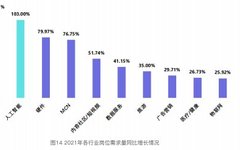
The “2021 China Computer Vision Talent Research Report” is produced by Jishiang Technology and Jishi Platform, and is divided into five chapters. The first chapter presents the basic profile of computer vision talent in China; the second chapter covers the supply and demand situation of computer vision talent in the market; the third chapter discusses the development bottlenecks of computer vision talent; the fourth chapter focuses on the collaboration between industry, academia, and research to promote the training of computer vision talent; the fifth chapter compiles talent policies in the Chinese artificial intelligence industry from 2020 to 2021.
Among the many fields of artificial intelligence technology, computer vision has emerged as the largest technical direction in China’s artificial intelligence market. It has begun to show its potential in various industries including manufacturing, security, energy, healthcare, agriculture, finance, commerce, government, and public safety. This has driven innovation in industries and application scenarios, continuously giving rise to new business formats and models. According to Gartner’s 2021 AI technology maturity curve, computer vision technology has crossed the expectation inflation phase and is expected to be mainstream in the next 2-5 years, achieving large-scale commercial deployment and benefiting our lives.
It is evident that whether it is industries, companies, or end consumers, there is a strong desire to embrace computer vision technology, providing a broad demand market for its full adoption. However, on the supply side of technology and industry, the shortage of related talent has become increasingly prominent, facing more severe challenges.
01Basic Profile of Computer Vision Talent in China
Preferences and Habits of Computer Vision Talent Development
Preferred programming languages among computer vision talent: Among university students, the most commonly used programming language is Python, with significantly more users than other languages. This is because Python, as the most mainstream programming language today, offers advantages in terms of concise and rapid coding, ease of entry, and powerful functionality. However, in the industrial sector, due to high demands for model deployment, Python faces more limitations in practical implementation compared to languages like C or C++. Therefore, working professionals tend to use C/C++ and JavaScript more frequently than university students.
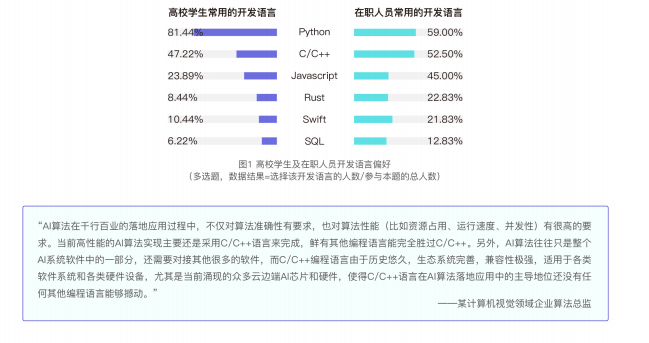
Preference for deep learning frameworks among computer vision talent: Among university students, the most commonly used deep learning framework is Pytorch, accounting for 75.22%. For working professionals, Pytorch and TensorFlow are equally popular. Notably, compared to 2020, the usage rate of domestic deep learning frameworks among university students increased from 1.58% to 28.44%, and among working professionals, it rose from 6.49% to 30.67%. This indicates that as the application range, scenarios, and depth of domestic deep learning frameworks gradually improve, their usage rates in both academia and industry have significantly increased.

Work Unit Preferences of Computer Vision Talent (University Students)Survey data shows that in 2021, the top five preferred work units among university students were: Artificial Intelligence (55.89%), Research Institutes (38.89%), Internet Companies (35.44%), Universities (34.33%), and Government (16.33%). It is clear that artificial intelligence remains the most popular choice for students, with an increase in preference compared to 2020 data (48.84%).
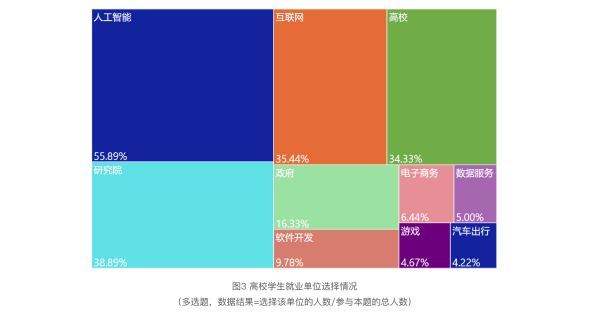
From a professional perspective, students majoring in Artificial Intelligence, Computer Science and Technology, Electronics and Information Engineering, Automation, etc., all prefer to work in artificial intelligence companies. Among students majoring in Artificial Intelligence, nearly half chose research institutes and universities as their second option. Additionally, Internet companies are also a major employment choice for many students specializing in computer vision.
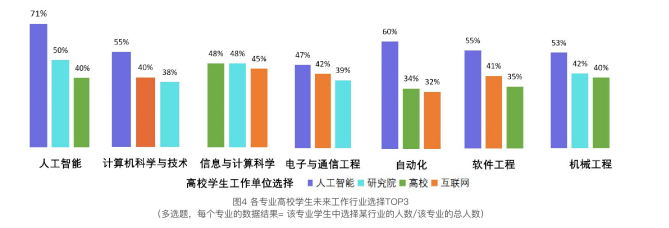
Salary Levels of Computer Vision Talent (Working Professionals)
Through surveys of working professionals in the computer vision field, the research team focused on the salary distribution of four positions: Algorithm Engineers, R&D Engineers, Algorithm Researchers, and AI Product Managers. It is evident that Algorithm Researchers generally have higher salaries, averaging over 200,000. In terms of the proportion of high-income individuals (over 600,000), algorithm positions (Algorithm Engineers & Algorithm Researchers) overall exceed R&D and product positions. Furthermore, Algorithm Researchers lead the algorithm positions with the highest proportion of high-income individuals (over 800,000) at 3.70%. Considering work experience, the salary range for positions with less than three years of experience is between 220,000/year and 300,000/year, with Algorithm Researchers having the highest average salary of 300,000/year. In the transition from entry-level professionals (experience < 3 years) to experienced professionals (3 < experience < 5 years), both Algorithm Engineers and AI Product Managers experience significant salary increases of 54% and 45%, respectively.

Development of AI Programs in Chinese UniversitiesIn recent years, Chinese universities have strengthened the training of talent in artificial intelligence technology and industry through various means, continuously supplying skilled professionals to academia and industry. In terms of AI program development, there are currently 440 undergraduate institutions in China offering AI programs. Among these, 81 are 985 and 211 institutions, 113 are first-tier universities, and 246 are second-tier universities.Regarding the establishment of professional courses, the research team found that nearly all of the 50 985 and 211 institutions that have publicly disclosed their program development plans offer foundational courses such as Machine Learning, Programming Design, and Introduction to Artificial Intelligence. Additionally, core courses such as Natural Language Processing, Machine Learning, and Computer Vision are also key focuses in the academic discipline development of these universities.
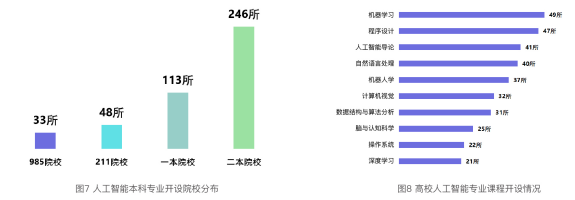
Comparison of Research Fields: Academia vs. Industry
By comparing the differences in research fields between academia and industry, it was found that industry pays more attention to subfields such as pose estimation, facial recognition, and 3D vision than academia. This indicates that computer vision technology has seen many successful practices in these research directions. Conversely, in research directions such as multimodal learning and few-shot learning, academia shows a higher level of research interest, indicating that there is still a significant amount of research work to be done in these areas, which have not yet entered the stage of industrial application.
Therefore, in future research, for research directions with many practical applications, universities should remain attentive and seek new technological breakthroughs to enhance industry efficiency. Meanwhile, for exploratory frontier directions, both enterprises and universities need to jointly focus on the potential for practical applications in the industry, promoting the application and transformation of research results in the industry.
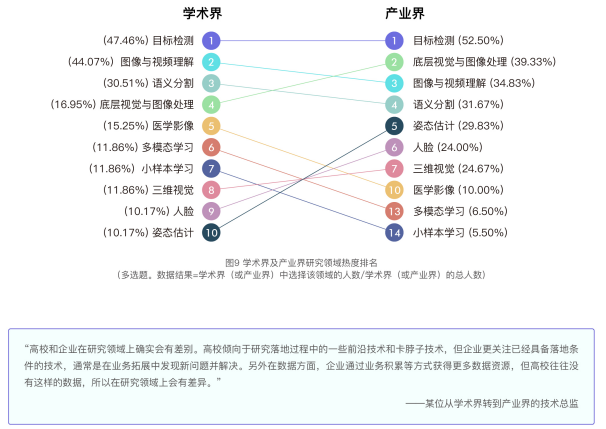
Geographical Distribution and City Preferences of Computer Vision TalentData from Jishi Platform shows that nearly 80% of computer vision talent in China is concentrated in first-tier and new first-tier cities with abundant AI industry resources, high demand for talent, diverse job positions, and strong urban hubs. In this survey, the classification of cities mainly refers to the “2021 Urban Commercial Charm Ranking” published by Yicai. First-tier cities include: Beijing, Shanghai, Guangzhou, and Shenzhen; new first-tier cities include: Chengdu, Hangzhou, Chongqing, Wuhan, Xi’an, Suzhou, Tianjin, Nanjing, Changsha, Zhengzhou, Dongguan, Qingdao, Shenyang, Foshan, and Ningbo.Beijing, Shanghai, Shenzhen, Hangzhou, Xi’an, and Guangzhou are the top six cities with the most computer vision talent, with the total number of talent in these six cities exceeding 50% of the national total. Additionally, as a representative of new first-tier cities, Hangzhou and Xi’an have surpassed Guangzhou in terms of talent reserves in the computer vision field, ranking fourth and fifth nationwide, respectively.
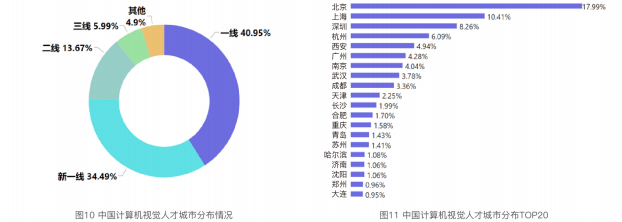
In terms of city preferences, the vast majority of computer vision talent still choose first-tier cities as their future development options. Among them, the highest number of choices is for Shanghai (46.8%), followed by Beijing (42.4%), Shenzhen (29.6%), and Guangzhou (17.93%). New first-tier cities have seen rapid growth in recent years, with Hangzhou (11.4%) being the most popular choice among computer vision talent.To explore the factors that computer vision talent consider when choosing future cities for development, the research team conducted in-depth surveys focusing on multiple dimensions such as policies, housing prices, city culture, living habits, and cost of living, excluding the two dominant factors of job positions and salary levels. The survey data indicates that government talent introduction policies, social resources and public service levels, regional economic development levels, housing prices, and family emotional factors are the five most important factors. Among these, government talent introduction policies are the most significant factor, accounting for 65.47%.
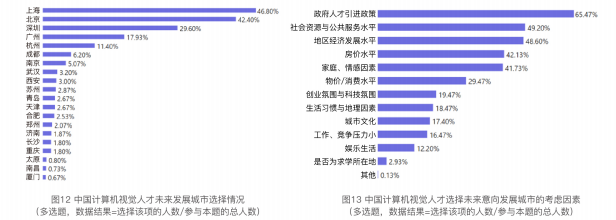
02Market Supply and Demand Situation of Computer Vision Talent in ChinaContinuous High Growth in Demand for Computer Vision TalentThe rapid development of the artificial intelligence industry has intensified the demand for talent, making AI technology and industry talent highly sought after. Moreover, as talent is one of the most critical factors in promoting the rise and rapid development of China’s AI industry, its quality, level, and scale will determine the future height of AI development in China. According to data from Lagou Recruitment Research Institute, the job demand in the AI industry in 2021 increased by approximately 103% year-on-year, ranking second across all industries.
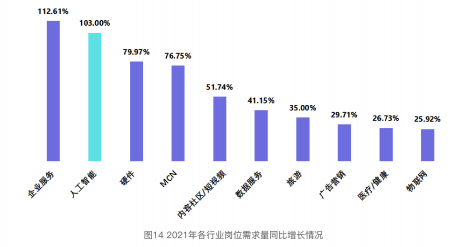
Additionally, the research team collected data on the job postings from nearly 600 companies with a demand for computer vision talent on the Lagou recruitment platform. Data shows that from 2019 to 2021, the demand and number of job postings for computer vision technology and product positions have been continuously increasing. Specifically, the annual growth rate for recruitment in computer vision technology positions is 49%, and for product positions, it is 42%. In 2021, the total number of job postings on the platform for computer vision technology and product positions was 18,475 and 11,200, respectively.
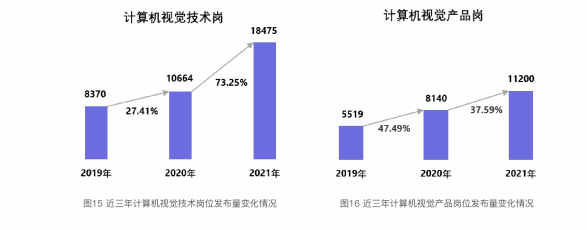
Severe Shortage of Computer Vision Talent Supply, with AI Product Positions Exhibiting the Most Prominent Supply-Demand ConflictOn the other hand, the flourishing industry has highlighted the increasingly prominent shortage of computer vision talent. According to predictions by the talent exchange center of the Ministry of Industry and Information Technology, it is estimated that by 2022, there will be a talent gap of approximately 480,000 in China’s AI field.To address the supply-demand situation of talent in the computer vision field, the research team focused on 90 representative companies in the domestic computer vision sector and conducted in-depth interviews with several company representatives. The companies reported that the current shortage of computer vision talent supply has not seen significant improvement, especially for certain specialized positions where the demand-supply gap is more pronounced. The research on the demand for talent in various specialized positions in the computer vision field revealed that the demand for Algorithm Engineers is the highest (90.28%), followed by R&D Engineers (64.44%). In addition to these two positions, there is also a pressing demand for AI Product Managers (48.89%) and Algorithm Researchers (46.67%).
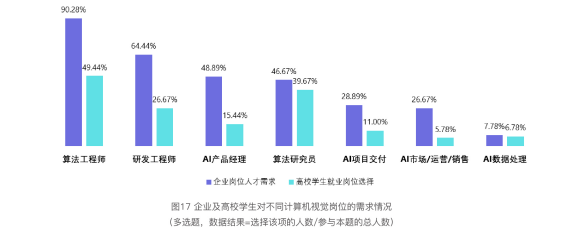
Structural Imbalance in Computer Vision Talent May Be the Core Reason for Supply-Demand ConflictIn terms of work experience requirements, whether for technical or product positions in the computer vision field, 3-5 years of work experience is the common requirement from companies. For talents with less than one year of experience, 24.99% of companies are willing to offer technical positions, while this percentage is only 3.34% for product positions. This indicates that the current demand for talent in China’s computer vision industry has high expectations for work experience and capabilities.
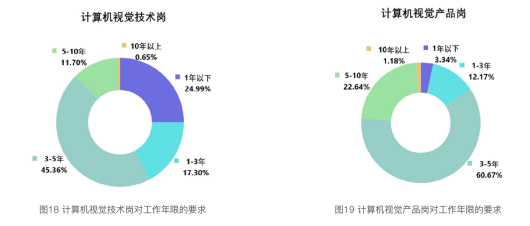
However, according to relevant survey data on talent work experience, it is found that the algorithm development experience and coding engineering experience of computer vision talent are generally concentrated within 3 years, with proportions of 61.73% and 69.47%, respectively. Only about 30-40% of talent meet the basic profile required by companies. By comparing the requirements for work experience with the current state of talent algorithm experience, it is evident that there is a significant structural imbalance in computer vision talent in China.
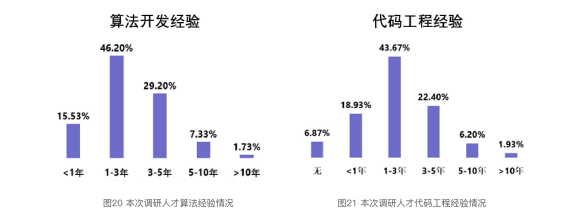
03
Development Bottlenecks of Computer Vision Talent in China
Individual Development Issues of Computer Vision TalentSurvey data indicates that the personal development bottlenecks of computer vision talent and the core issues affecting talent supply are concentrated in two aspects: “insufficient professional knowledge/skill reserves” and “unclear career development direction”. Issues related to insufficient professional knowledge/skill reserves mainly include deficiencies in technical abilities, project experience, internship experience, competition experience, and work skills. Problems related to unclear career development direction mainly include a lack of clarity regarding career planning, job positions, salary, and promotion opportunities. In subsequent chapters, the research team will conduct an in-depth analysis of these two major issues that restrict talent development and supply, aiming to provide reference suggestions for enterprises, universities, and the government in talent development and training.

Insufficient Professional Knowledge and Skill Reserves of TalentThe research team found through questionnaires and in-depth interviews that one of the main reasons for the lack of effective computer vision talent is the serious inadequacy of professional knowledge and work skills, which cannot meet the demands of enterprises and industry development. The research team believes that the difficulties in talent’s professional knowledge and skill reserves are primarily due to the continuously increasing standards for talent capabilities set by enterprises and the lack of a mature talent training system for both soft and hard skills from both sides of enterprises and universities.Continued Increase in Recruitment Standards by Enterprises:In this survey, computer vision companies expressed and increased their requirements for talent’s educational background and major. Firstly, regarding educational preferences, over 80% of companies indicated that they prefer to recruit individuals with a master’s degree or higher. Among these, master’s degree holders account for the highest proportion at 56.86%. In contrast, only 18.63% of companies extend offers to candidates with a bachelor’s degree. The research team believes that the reason for this educational preference is primarily due to the fact that during the undergraduate stage, the relevant course offerings in universities are mainly focused on general AI courses, leading to students having limited exposure to professional knowledge, research topics, and project resources. This results in students being unable to meet the demands of enterprises in terms of professional capabilities and practical experience. Secondly, according to survey data, the two most preferred majors by enterprises are Computer Science and Technology and Artificial Intelligence. Compared to 2020, Artificial Intelligence has risen to be equally important as Computer Science and Technology, with a significantly higher preference ratio than other majors, indicating that enterprises are increasingly valuing the relevance of students’ majors to their future roles as reserve talent..
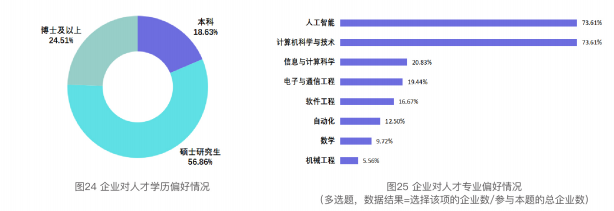
Lack of a Mature Talent Training System between Enterprises and Universities, Insufficient Training of Soft and Hard SkillsThrough the research on enterprises’ preferences for talent’s soft and hard skills, it was found that, in terms of soft skills, companies value talents’ innovation capacity, problem-solving ability, and learning ability the most. In terms of hard skills, in addition to requirements for professional knowledge, companies pay more attention to whether candidates have relevant project experience and research/internship experience in the field of computer vision when recruiting talent.
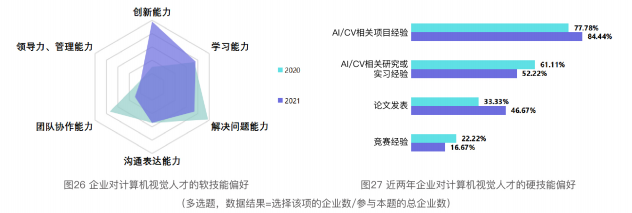
Unclear Career Development Direction of TalentThrough the survey, we found that another major issue faced by computer vision talent in their personal development is the “unclear career development direction”. The confusion regarding career planning and technical advancement directions also contributes to the supply-demand imbalance of specialized positions within the industry. The research team believes that the main factors leading to the unclear career development direction of talent are the lack of clear promotion paths for specialized positions in the field of computer vision, the absence of a standardized promotion system, and the tendency to blindly apply traditional internet industry promotion systems, which makes it difficult for startups to address the issue effectively. Professionals in the industry face a common topic regarding job promotions. For those engaged in traditional industries, establishing a reasonable promotion path in their career planning is not difficult. However, for talents in emerging industries like computer vision, they often do not receive clear and ideal answers. This is because traditional industries have already formed relatively mature development chains, and each link in the industrial chain has established relatively clear employment needs. When planning their careers, talents can consider horizontal development, such as transitioning from production roles in the industrial chain to sales roles, or vertical development, focusing on a specific subfield to continuously enhance their professional strength.04Industry-Academia-Research Collaboration to Support Computer Vision Talent Development
In order to help computer vision talent clarify their career development direction, quickly enhance their professional knowledge and skill levels, and thus meet the actual demands of enterprises and improve the current imbalance in the supply and demand of talent in the field of computer vision, the research team attempts to propose some reference suggestions from the perspectives of universities and enterprises.
Strengthening the Construction of an Industry-Oriented Talent Training System through School-Enterprise Cooperation
As the most important carrier for cultivating and supplying computer vision talent in China, the talent training system and methods of universities have a profound significance and impact on solving the imbalance in supply and demand of talent in this field. To help students in the field of computer vision further build a solid foundation of professional knowledge, enhance their soft and hard skills, accumulate practical experience in industry projects, and form initial career development plans, the research team suggests that universities actively explore school-enterprise cooperation models, utilize enterprise and social resources, and try to introduce external mentors from enterprises to form a “dual-teacher” teaching model. This can be achieved through joint course development, professional co-construction, business project cooperation, and practical training projects, establishing an industry-oriented talent training system that helps students overcome the barriers to employment in enterprises.
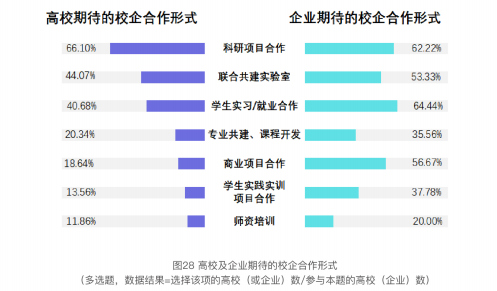
Collaborating with Industry Resources to Create a Standardized Promotion System and Internal Training SystemTo address the issue of unclear career planning for talent, enterprises should refer to and learn from the relatively standardized promotion systems of large traditional internet companies while combining their industry and development needs to propose clear job responsibilities and develop corresponding performance reward plans based on work output, gradually establishing an internal talent evaluation system. This will help balance the supply of talent with the pace of enterprise development, reduce the difficulty of talent recruitment, and mitigate the risks associated with talent turnover. In addition, enterprises can also collaborate with government, industry associations, and other organizations to jointly establish a talent competency standards system for the computer vision industry. Through top-level design, corresponding career planning proposals can be developed for different positions, forming a consensus within the industry.To address the issue of insufficient professional knowledge and skill reserves of talent, on the industry side, enterprises should proactively establish internal talent training systems to help working professionals quickly enhance their professional knowledge and work skills in the field of computer vision. Starting from internal training, enterprises can directly cultivate talents with strong learning and application abilities for specific roles, develop upward development paths for talent, and continuously organize internal technical exchange and sharing activities. This will maximize the utilization of talents’ autonomy, assign suitable work based on their skills, and protect the innovative environment for high-quality talent, thereby enhancing the technical strength and business expansion of enterprises. Additionally, enterprises can actively seek external professional resource support and establish partnerships with vocational training institutions for soft and hard skills training, organizing training sessions at fixed times to provide employees with opportunities for collective learning and enhancement of the soft skills required for their work, laying a solid foundation for the continuous improvement of talent within the company.05Compilation of Talent Policies in China’s Artificial Intelligence Industry (2020-21)The “14th Five-Year Plan for National Economic and Social Development of the People’s Republic of China and the Long-Range Objectives Through the Year 2035” proposes that China should focus on promoting the development of the artificial intelligence industry and the innovation of key AI technologies. As a core production factor, talent plays a crucial role in promoting technological and industrial development. In recent years, various policies related to the development of talent in the artificial intelligence industry have emerged, covering aspects such as talent introduction, training, evaluation, incentives, and guarantees.In terms of policy types, talent policies can generally be divided into: talent supply policies, talent demand policies, and talent environment policies. In different stages of industrial development, the types of talent policies often have different emphases. By analyzing the content and types of policies, it is helpful to understand the current focus of talent policies under the development stage of the artificial intelligence industry and can also assist talent, enterprises, and universities in making better decisions. Specifically, on one hand, it can provide supporting information for talent employment decisions, and on the other hand, it can offer guidance for enterprises and universities in talent cultivation and evaluation. This research collected nearly 64 policy documents related to talent development from the state and key provinces and municipalities over the past two years (2020-2021), filtering those related to talent development, including notices, plans, opinions, outlines, and action plans.
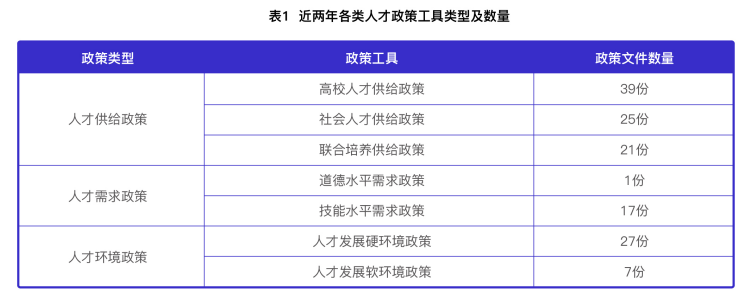
Overall, China is currently paying great attention to the talent supply side, namely the introduction and training of talent in the artificial intelligence industry, and is focusing on the supply of talent from universities as a primary effort. Policies regarding the moral and skill level requirements for talent are still in the exploratory stage, necessitating the introduction of more specific and targeted measures in conjunction with the industrial development situation. In terms of talent environment policies, regions generally focus on the “hard conditions” that guarantee talent development, aiming to address the material conditions needed for talent introduction and cultivation. Based on these findings, enterprises and talent can adjust their talent cultivation, evaluation, and employment decisions in a targeted manner according to policy trends. For example, AI companies can increase their cooperation with universities in innovative talent cultivation and skills training; leading enterprises can collaborate with local governments to leverage the “hard conditions” support for talent development, actively introducing high-end skilled talent in the industry; and young technology talents can explore various employment methods, actively responding to local innovation and entrepreneurship calls, utilizing various resources provided by the government and society to establish more enterprises in the field of artificial intelligence.The above is a portion of the 2021 China Computer Vision Talent Research Report for reference.Reply to this public account with “Computer Vision Talent” to download this document.Related Highlights:
Good News! The list of all winners of the 2021 Smart Push Power Award is here!
Series of Observations on the Artificial Intelligence Industry Part One | This technology has already been used in the American education sector.
Member Dynamics | Passing the Winter Olympics Torch! A 23-year relay race for technologists.

Official Website: www.zhinengxiehui.com
Official Email: [email protected]
Contact Person: Ms. Liu 15815953745
